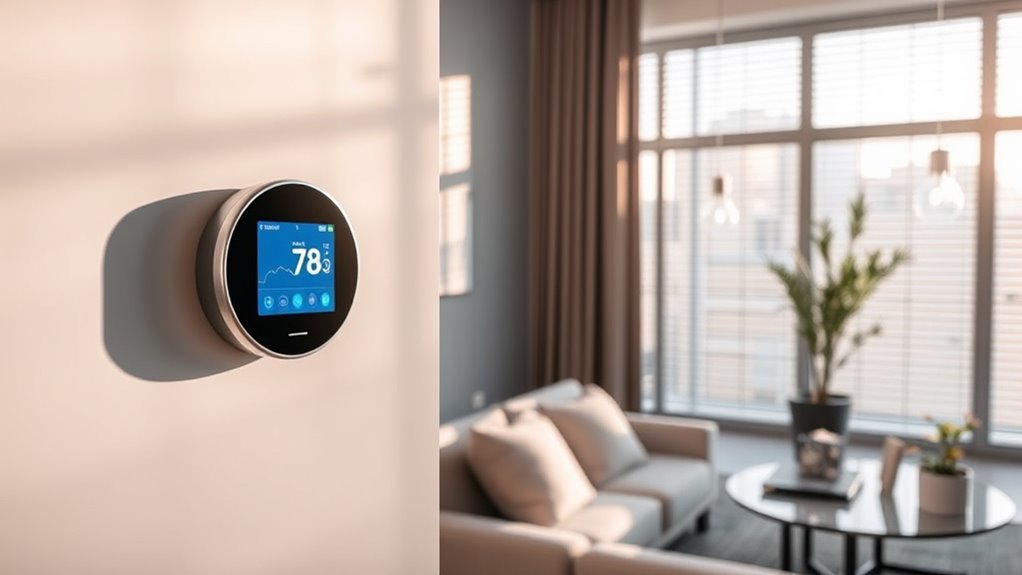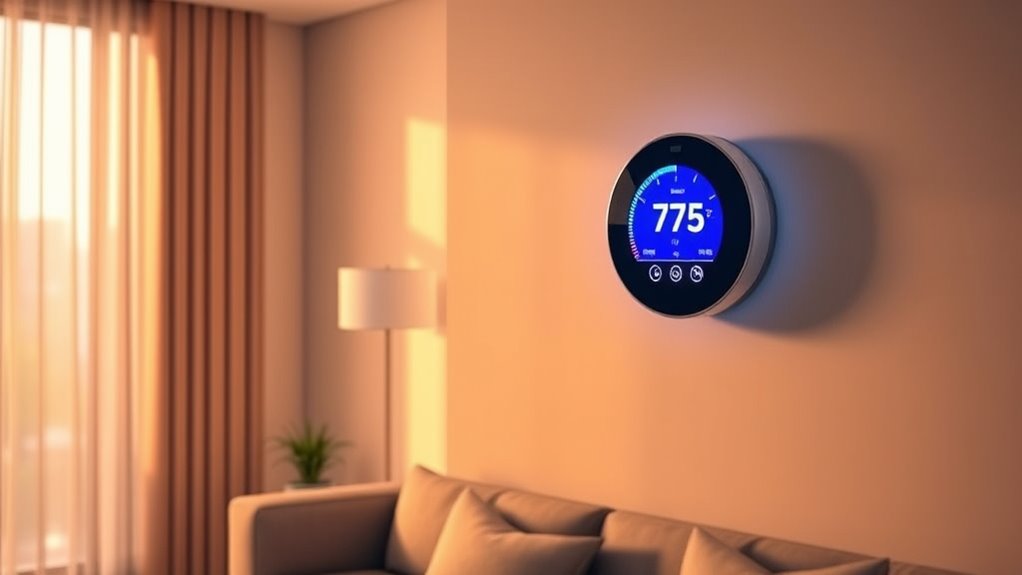By using smart thermostats, you can effectively reduce peak load charges by automating your heating and cooling schedules during high-demand periods. These devices respond to utility signals or weather forecasts, adjusting your home’s temperature without sacrificing comfort. This helps lower your energy bills and supports grid stability. With features like remote control and real-time adjustments, smart thermostats make peak load management easier. Keep exploring to discover how these devices can optimize your energy use even further.
Key Takeaways
- Smart thermostats automatically reduce HVAC usage during peak demand periods, lowering energy costs and avoiding high peak charges.
- They enable participation in demand response programs, which provide financial incentives for reducing peak load.
- Customizable schedules and remote control allow users to shift energy use away from expensive peak times efficiently.
- Real-time alerts and automation help optimize energy consumption, balancing comfort with peak load mitigation.
- Data insights from smart thermostats support ongoing adjustments to minimize peak energy consumption and costs.

As energy costs rise, managing peak load charges becomes increasingly vital for homeowners and businesses alike. One effective way to do this is through demand response strategies, which help reduce electricity consumption during periods of high demand. Smart thermostats play an essential role in this effort by enabling you to optimize your energy use intelligently. They can automatically adjust your heating and cooling systems based on real-time signals from your utility provider, helping you participate in demand response programs seamlessly. This not only lowers your energy bills but also supports grid stability by reducing strain during peak hours.
By leveraging smart thermostats, you gain better control over your energy consumption, which is key to energy optimization. These devices learn your schedule and preferences over time, adjusting temperature settings to guarantee comfort while minimizing unnecessary energy use. For example, during the hottest afternoons or coldest nights, your thermostat can slightly reduce or increase temperature levels without sacrificing comfort, thereby cutting back on excessive energy use during critical peak periods. This proactive approach allows you to shift consumption away from expensive, peak times, saving you money and easing the burden on the power grid.
Smart thermostats optimize comfort and energy use by learning your schedule and adjusting temperatures during peak periods.
Additionally, many smart thermostats come with features that enable you to set customized schedules or remotely control your system via smartphone apps. This flexibility means you can make real-time adjustments based on weather forecasts, occupancy, or utility alerts. When the utility company signals a demand response event, your thermostat can automatically respond by reducing HVAC load, helping you participate in programs that offer financial incentives. Such automation simplifies energy management, turning what might be a complex process into a straightforward, efficient routine.
Furthermore, smart thermostats contribute to overall energy efficiency by providing detailed insights into your consumption patterns. With this data, you can identify opportunities to fine-tune your heating and cooling habits, making your energy optimization efforts more effective. Some models also support backup power options to ensure continued operation during outages, enhancing their reliability. Over time, these adjustments can lead to significant savings on your energy bills and a smaller environmental footprint. It’s a win-win situation: you save money, support grid reliability, and reduce your carbon footprint without sacrificing comfort.
Frequently Asked Questions
How Do Smart Thermostats Identify Peak Load Periods Automatically?
Smart thermostats automatically identify peak load periods by analyzing your energy consumption patterns and comparing them to historical data. They monitor real-time usage, detecting when energy demand spikes, often during hot afternoons or cold mornings. By considering your user preferences, these thermostats adjust heating or cooling proactively, helping you save on energy costs while maintaining comfort. This intelligent approach guarantees you’re never caught off guard during peak times.
Can Smart Thermostats Be Integrated With Existing Home Automation Systems?
You can definitely integrate smart thermostats with your existing home automation systems, making life a breeze. Just check the integration compatibility of your devices to guarantee they work together smoothly. This setup allows for automation customization, so you can tailor your climate control to fit your lifestyle perfectly. Think of it as hitting two birds with one stone—enhancing comfort and efficiency without the hassle of starting from scratch.
What Are the Cost Savings Associated With Using Smart Thermostats for Peak Load Management?
Using smart thermostats for peak load management can substantially reduce your energy costs, leading to noticeable utility bill savings. By intelligently adjusting your home’s temperature during peak hours, you avoid costly demand charges and lower overall energy consumption. This energy cost reduction helps you save money monthly, especially during high usage periods. Over time, these savings add up, making smart thermostats a smart investment for managing your energy expenses effectively.
Are There Any Privacy Concerns With Data Collected by Smart Thermostats?
Think of your smart thermostat as a guarded treasure chest; it holds your data securely. Privacy concerns are real, but manufacturers use data encryption to protect your information, ensuring your personal habits stay private. They also prioritize user anonymity, preventing your identity from being linked to your data. So, you can enjoy the benefits of smart technology without worry, knowing your privacy remains a top priority.
How Do Smart Thermostats Adapt to Different Climate Zones for Optimal Performance?
Smart thermostats adapt to different climate zones by using climate zone customization features. They analyze your local weather data and automatically adjust temperature settings for ideal comfort and energy efficiency. With adaptive temperature settings, you don’t have to manually change your thermostat seasonally. Instead, it learns your preferences and modifies its operation based on your climate zone, ensuring consistent comfort while reducing energy costs throughout the year.
Conclusion
By harnessing smart thermostats, you take control of your energy use, turning peak charges into manageable savings. Think of these devices as your loyal allies, silently working behind the scenes to ease your wallet and protect the grid. Embrace this technology, and you’ll not only cut costs but also contribute to a more sustainable future. It’s like steering your home’s energy flow with a gentle hand, making a big difference with every thermostat adjustment.









